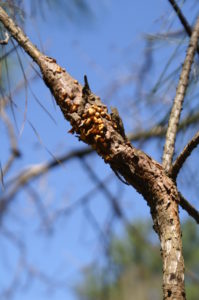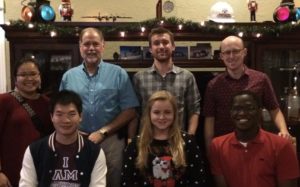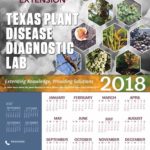 Fusiform Rust of Loblolly (Pinus taeda) and Slash (P. elliottii) Pines
Fusiform Rust of Loblolly (Pinus taeda) and Slash (P. elliottii) Pines
SCIENTIFIC NAME of causal agent: Cronartium quercuum f. sp. fusiforme
DISEASE DESCRIPTION
This disease, called fusiform rust, is considered the most damaging diseases of southern pine forests. As such, fusiform rust causes significant economic losses in commercial timber production.
SYMPTOMS:
Galls (abnormal growths of plant tissue) and cankers (areas of dead tissue) form on stems and branches of infected trees. Infections from the rust on trees under five years old are more likely to kill the tree; infections on trees older than five do not usually kill the trees, but there is an economic loss if used for timber.
Cankers produce a flammable resin or pitch that may catch fire during burning events or wildfires.
BIOLOGY:
The fusiform rust fungus is a heteroecious rust, which means that it requires an alternate host in some stages of development. In addition to infecting pines, the pathogen will use oaks as an alternate host. The pathogen uses wind to disperse from infected to healthy trees. In March, orange aeciospores form on the galls of pines and disperse to infect oaks. In late spring to early summer, basidiospores formed on the underside of oak leaves are used to infect pines at growing tips by wind dispersion.
MANAGEMENT METHODS:
When galls form on landscape trees, they may be removed from the tree using proper pruning techniques.
A major method of managing Fusiform rust in commercial timber production is to use resistant varieties. Additionally, planting less dense stands and in uneven age distributions patterns helps to reduce disease spread in commercial pine plantations.
Removal of infected plants and thinning of trees with galls is necessary to reduce the production of inoculum (spores). The removal of infected oaks, when applicable, in the surrounding area can also reduce the spread of the pathogen.
RESOURCE LINKS:
Visit the Texas A&M Forest Service link for more practices to combat Fusiform rust.
This factsheet is authored by Roy Davis (PhD student)

Dr. Appel’s 2017 Fall PLPA601 students
Factsheet information for the plant health issues represented by the images on the 2018 TPDDL calendar were written by graduate students enrolled in the Department of Plant Pathology & Microbiology PLPA601 Introductory Plant Pathology course in the 2017 Fall semester (course instructor: Dr. David Appel). This exercise provides an opportunity for a high impact learning activity where the students are tasked with producing an informational output directed to the general public and to provide opportunity for the students to write.

CLICK HERE to return to 2018 TPDDL Calendar page